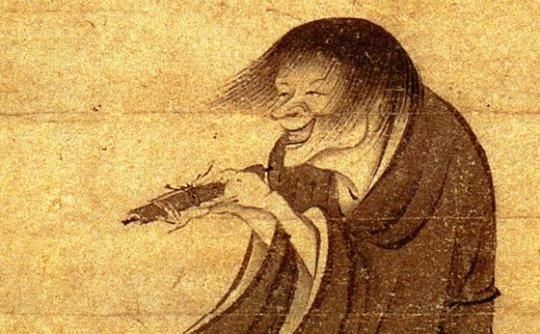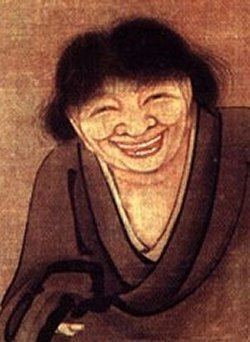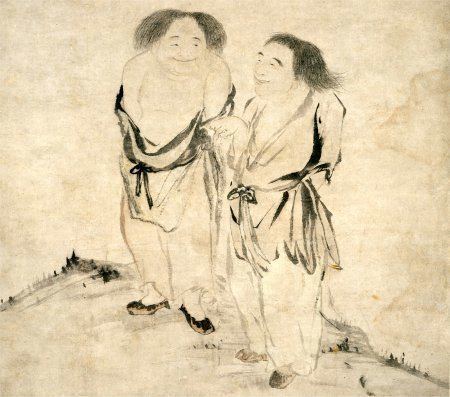 | ||
Books Cold Mountain poems, Poems of Hanshan, The collected songs of Cold Mountain, View from Cold Mountain Similar Shide, Gary Snyder, Ezra Pound, William Carlos Williams, Robinson Jeffers | ||
Hanshan (Chinese: 寒山; pinyin: Hánshān; literally: "Cold Mountain", fl. 9th century) was a legendary figure associated with a collection of poems from the Chinese Tang Dynasty in the Taoist and Chan tradition. No one knows who he was, or when he lived and died. In the Buddhist tradition, Hanshan and his sidekick Shide are honored as emanations of the bodhisattvas Mañjuśrī and Samantabhadra, respectively. In Japanese and Chinese paintings, Hanshan is often depicted together with Shide or with Fenggan, another monk with legendary attributes.
Contents

Little is known of his work, since he was a recluse living in a remote region and his poems were written on rocks in the mountains he called home. Of the 600 poems he is thought to have written at some point before his death, 313 were collected and have survived. Among the 57 poems attributed to Hanshan's friend, Shide, seven appear to be authored by Hanshan, for a total of 320.

Date

In Lu Jiuyin's (Wade–Giles: Lu Ch'iu-Yin) preface to Hanshan's poems, he claims to have personally met both Hanshan and Shide at the kitchen of Guoqing Temple, but they responded to his salutations with laughter then fled. Afterwards, he attempted to give them clothing and provide them housing, but Lu Jiuyin writes that the pair fled into a cave which closed itself and Shide's tracks disappeared. This led Lu Jiuyin, governor of Tai Prefecture, to collect Hanshan's writings, "the poems written on bamboo, wood, stones, and cliffs — and also to collect those written on the walls of peoples' houses." However, Burton Watson is of the opinion that Lu Jiuyin did not exist in reality and that his preface to Hanshan's poems is nothing more than myth. In the introduction to his book, he says of Lu Jiuyin's preface to the poems:

[The preface], contrary to Chinese custom, is undated. Lu-chiu Yin represents himself as a high official and prefixes his name with a very imposing title. But there is only one mention of anyone by this name to be found in other works of the period, and it refers almost certainly to another person. This fact alone is peculiar enough, if Lu-chiu Yin was in fact as high up in the bureaucracy as his title indicates. Furthermore, the style of the preface, awkward and wordy, hardly suggests the writing of an eminent official. All other sources that tell us anything about Han-shan and Shih-te appear to be later than the preface and based upon it. For all we know, therefore, the whole picture of the two recluses built up in the preface may be nothing more than literary fiction. The poems, however, remain — over three hundred of them....If the reader wishes to know the biography of Han-shan, he must deduce it from the poems themselves.

If we follow Watson and discount the preface of Lu Jiuyin, accepting only the words of the poet himself, we see that Hanshan says only that he wrote his poems on the rocks. Nowhere in the poetry does he say that he wrote them on trees or bamboo or wood or the walls of people’s houses.
The collection of poems attributed to Hanshan may span the entire Tang Dynasty as Edwin G. Pulleyblank asserts in his study Linguistic Evidence for the Date of Hanshan. Wu Chi-yu in A study of Han-shan identifies him as the monk Zhiyan (智岩, 577–654), but that has been disputed by Paul Demiéville among others. The Encyclopedia of China gives his date as around 712 and after 793. Jia Jinhua came to the conclusion, after a study of Chan phrases in some 50 of the poems, that this particular group of poems may be attributable to the Chan monk Caoshan Benji (840–901). However, the dates for both Zhiyan and Caoshan Benji contradict Hanshan, who says that he was much older than either.
Translations
Early translations by Arthur Waley 27 poems by Han-shan, Gary Snyder Cold Mountain Poems, and Burton Watson Cold Mountain: 100 Poems.
The first complete translation to a western language was into French by Patrick Carré (Le Mangeur de brumes : l'œuvre de Han-shan poète et vagabond). Stephan Schumacher translated 150 poems into German in 1980.
There are three full English translations, by Robert G. Henricks, Red Pine. and Paul Rouzer
Other translations: Encounters With Cold Mountain, by Peter Stambler (130 poems). Cold Mountain Transcendental Poetry (96 poems) by Wandering Poet (2005, 2012).
Biography
“If the reader wishes to know the biography of Han-shan, he must deduce it from the poems themselves.”
Poetry
Hanshan's poetry consists of Chinese verse, in 3, 5, or 7 character lines; never shorter than 4 lines, and never longer than 34 lines. The language is marked by the use of more colloquial Medieval Vernacular Sinitic than almost any other Tang poet. The poems can be seen to fall into three categories: the biographical poems about his life before he arrived at Cold Mountain; the religious and political poems, generally critical of conventional wisdom and those who embrace it; and the transcendental poems, about his sojourn at Cold Mountain. They are notable for their straightforwardness, which contrasts sharply with the cleverness and intricateness that marked typical Tang Dynasty poetry.
Red Pine poem 283:
Mister Wang the Graduatelaughs at my poor prosody.I don't know a wasp's waistmuch less a crane's knee.I can't keep my flat tones straight,all my words come helter-skelter.I laugh at the poems he writes-a blind man's songs about the sun!(All these terms refer to ways a poem could be defective according to the rigid poetic structures then prevalent.)
Thematically, Hanshan draws heavily on Buddhist and Taoist themes, often remarking on life's short and transient nature, and the necessity of escape through some sort of transcendence. He varies and expands on this theme, sometimes speaking of Mahayana Buddhism's 'Great Vehicle', and other times of Taoist ways and symbols like cranes.
The following poem begins with the imagery of the burning house and the three carts from the Parable of the Burning House found in The Lotus Sutra, then ends with typical Zen and Taoist imagery of freedom from conceptualizations.
Red Pine poem 253:
Children, I implore youget out of the burning house now.Three carts await outsideto save you from a homeless life.Relax in the village squarebefore the sky, everything's empty.No direction is better or worse,East just as good as West.Those who know the meaning of thisare free to go where they want.This mixed influence is probably due to the high preponderance of Taoists and Buddhists in the same area. The eminent Taoist Ge Hong acclaimed Mount Tiantai as 'the perfect place for practicing the arts of immortality,' which is probably also why so many Buddhist temples were established in the vicinity as well.
Red Pine poem 13:
"Brothers share five districts;father and sons three states."To learn where the wild ducks flyfollow the white-hare banner!Find a magic melon in your dream!Steal a sacred orange from the palace!Far away from your native landswim with fish in a stream!Many poems display a deep concern for humanity, which in his view stubbornly refuses to look ahead, and short-sightedly indulges in all manner of vice, like eating animal flesh, piling up sins 'high as Mount Sumeru'. But he holds out hope that people may yet be saved; 'Just the other day/ a demon became a Bodhisattva.'
Red Pine poem 18:
I spur my horse past ruins;ruins move a traveler's heart.The old parapets high and lowthe ancient graves great and small,the shuddering shadow of a tumbleweed,the steady sound of giant trees.But what I lament are the common bonesunnamed in the records of immortals.While Hanshan eschewed fancy techniques and obscure erudition, his poems are still highly evocative at times: Red Pine poem 106:
The layered bloom of hills and streamsKingfisher shades beneath rose-colored cloudsmountain mists soak my cotton bandanna,dew penetrates my palm-bark coat.On my feet are traveling shoes,my hand holds an old vine staff.Again I gaze beyond the dusty world-what more could I want in that land of dreams?He is hard to pin down religiously. Chan concepts and terminology sometimes appear in his work. But he criticized the Buddhists at Tiantai, and he directed criticism at Taoists as well, having had no problem bringing Taoist scriptural quotations, and Taoist language when describing his mountains, into his poems. Yet, he does not mince words, but tells us precisely where to find the path to Heaven.
Red Pine poem 117:
I deplore this vulgar placewhere demons dwell with worthies.They say they're the same,but is the Tao impartial?A fox might ape a lion's mienand claim the disguise is real,but once ore enters the furnace,we soon see if it's gold or base.Red Pine poem 246:
I recently hiked to a temple in the cloudsand met some Taoist priests.Their star caps and moon caps askewthey explained they lived in the wild.I asked them the art of transcendence;they said it was beyond compare,and called it the peerless power.The elixir meanwhile was the secret of the godsand that they were waiting for a crane at death,or some said they'd ride off on a fish.Afterwards I thought this throughand concluded they were all fools.Look at an arrow shot into the sky-how quickly it falls back to earth.Even if they could become immortals,they would be like cemetery ghosts.Meanwhile the moon of our mind shines bright.How can phenomena compare?As for the key to immortality,within ourselves is the chief of spirits.Don't follow Lords of the Yellow Turbanpersisting in idiocy, holding onto doubts.The following poem is attributed to Hanshan's friend, Shide.
The higher the trail the steeper it growsTen thousand tiers of dangerous cliffsThe stone bridge is slippery with green mossCloud after cloud keeps flying byWaterfalls hang like ribbons of silkThe moon shines down on a bright poolI climb the highest peak once moreTo wait where the lone crane fliesRed Pine's poem 307:
Whoever has Cold Mountain's poemsis better off than those with sutras.Write them up on your screenand read them from time to time.Legacy
The poetry from Cold Mountain has influenced the poets of many generations and cultures. He is especially loved by the Japanese, who know him as Kanzan. Hanshan was a sympathetic and important figure for Beat Generation writers Gary Snyder and Jack Kerouac. In the introduction to his translation which appeared in the Evergreen Review, Snyder wrote of Hanshan, "He and his sidekick Shih-te (Jittoku in Japanese) became great favorites with Zen painters of later days — the scroll, the broom, the wild hair and laughter. They became Immortals and you sometimes run into them today in the skidrows, orchards, hobo jungles, and logging camps of America." Kerouac's The Dharma Bums closes with a vision of Hanshan, and at Snyder's suggestion, Kerouac dedicated the book to the fabled poet.
Paul Rouzer reads the poems as buddhist teaching poems, referring to Hakuin Ekaku Kanzan shi sendai kimon 寒山詩闡提記聞 (1746) ("Notes on the Lectures on Cold Mountain's Poems at Icchantika Cave") that largely ignores the biographical reading most commonly found in other sources.
